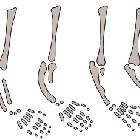Radialstrahldefekte bei Fanconi-Anämie

Radial ray
anomaly • Radial ray deficiency in Fanconi anemia - Ganzer Fall bei Radiopaedia
Radialstrahldefekte bei Fanconi-Anämie
Radialstrahldefekte Radiopaedia • CC-by-nc-sa 3.0 • de
Radial ray anomalies comprise of a large spectrum of upper limb anomalies which range from partial (radial hypoplasia) to a complete (radial aplasia) deficiency of the radius with or without accompanying deficiency of the thumb bones.
Pathology
Associations
They can be associated with a number of associations which include:
- Aase syndrome
- amniotic band syndrome
- Cornelia de Lange syndrome (CdLS)
- Duane radial ray syndrome (DRRS)
- Fanconi anemia
- Holt-Oram syndrome
- Nager syndrome
- omphalocoele-radial ray (ORR) complex
- Rothmund-Thomson syndrome (RTS)
- in utero teratogen exposure
- valproic acid: valproate embryopathy
- thalidomide: thalidomide embryopathy
- TAR syndrome: thrombocytopenia, absent radius syndrome
- trisomy 18
- VACTERL association
Subtypes
Radial ray anomalies can be classified into four main subtypes depending upon the extent of severity:
- type I: radius is slightly (>2 mm) short and the hand bends sideways at the wrist (often associated with a hypoplastic thumb); proximal radius usually unaffected
- type II: the radius bone is very short and the ulna curves sideways and supports the wrist poorly
- type III: partial absence of radius
- type IV: complete absence of radius
Radiographic features
Antenatal ultrasound
May show absent of hypoplasia of the radius (depending on type) with hand often in medial rotation
Plain radiograph
Allows direct visualization of anatomy but is usually performed postnatally.
Siehe auch:

 Assoziationen und Differentialdiagnosen zu Radialstrahldefekte bei Fanconi-Anämie:
Assoziationen und Differentialdiagnosen zu Radialstrahldefekte bei Fanconi-Anämie:



